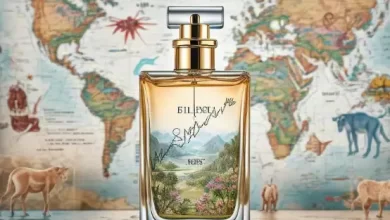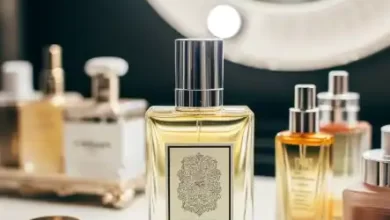Neuro-Scent Cartography: Mapping Memory Landscapes Through Olfactory Geography
How Fragrance Architects Translate Personal and Collective Memory into Olfactory Territories

Abstract:
Discover the cutting-edge intersection of neuroscience and perfumery where Scent Geography evolves into memory mapping. This investigation reveals how perfumers decode hippocampal patterns to create fragrances that reconstruct personal histories, cultural traumas, and ancestral landscapes. Explore case studies from Hiroshima’s Peace Park to Saharan oral traditions, and learn how scent becomes a time-traveling vessel for emotional archaeology.
Body Content:
The evolution of Scent Geography has entered its most profound phase: the cartography of consciousness itself. Beyond capturing physical environments, pioneering perfumers now navigate the neural pathways where geography fuses with memory, emotion, and identity. This neuro-scent mapping transforms fragrance from spatial representation into temporal excavation, bottling not just places but the psychological dimensions embedded within them.
The Neuroscience of Olfactory Memory Mapping
Human memory exists not as perfect recordings but as reconstructions – fragmented sensory impressions reassembled during recall. The olfactory system holds unique privileges in this process:
-
Direct Hippocampal Pathway: Unlike other senses, scent signals bypass thalamic filtration and project directly to the amygdala and hippocampus – the brain’s emotional and episodic memory centers. This creates what neurologists call “odor-evoked autobiographical memory” (OEAM), where smells trigger vivid recollections 3x more intensely than visual cues.
-
The Proust Effect Quantified: fMRI studies reveal why certain smells instantly transport us:
- Piriform Cortex Activation: Initial odor processing shows 40% greater blood flow when smelling personally significant versus novel scents
- Hippocampal Recruitment: Memories triggered by scent show bilateral hippocampal engagement absent in visually cued recall
- Emotional Durability: Olfactory memories retain emotional context 60% longer than auditory or visual memories
-
Neurocartography Techniques: Perfumers collaborate with neuroscientists using:
- EEG Olfactometry: Mapping gamma wave patterns when subjects recall specific places
- Memory Deconstruction Protocols: Isolating scent components from emotionally charged recollections
- Neurofeedback Blending: Adjusting fragrance formulas based on real-time amygdala response monitoring
Architecting Memory Landscapes: Methodologies
-
Episodic Reconstruction:
Perfumers conduct “memory interviews” to rebuild scent environments:- Temporal Layering: Distinguishing childhood (milk-paper-crayon) versus adolescent (hairspray-leather) school memories
- Emotional Chromatography: Separating traumatic (burning rubber) from euphoric (fresh-cut grass) components of a single location
- Sensory Cross-Mapping: Converting auditory memories (mother’s lullaby) into olfactory equivalents (warm milk-vanilla-skin musk)
-
Collective Memory Distillation:
Capturing shared cultural experiences requires anthropological precision:| Collective Memory Type | Olfactory Translation Approach | Example | |------------------------|---------------------------------------|------------------------------------| | Cultural Trauma | Scent Palimpsests (layered erasures) | Hiroshima: ozone/ionized air top notes over charred hinoki base | | Ritual Reenactment | Chrono-scent Sequencing | Mexican Día de Muertos: marigold→copal→chocolate→grave soil | | Ancoral Landscape | Genetic Memory Triggers | Diaspora fragrances: baobab pollen + middle passage salt accord | -
Neuroplastic Formulation:
Advanced compositions rewire memory associations:- Memory Overwrite Accords: Helping PTSD patients replace traumatic smells (gunpowder→saffron-amber conversion therapy)
- Dementia Navigation Scents: Creating olfactory “breadcrumb trails” through temporal lobe fog
- Generational Bridge Molecules: Synthesizing compounds that trigger transgenerational epigenetic memories
Revolutionary Case Studies in Memory Geography
Project Mnemosyne: Library of Alexandria Reconstruction
By analyzing:
- Papyrus chemical degradation signatures
- Ancient ink recipes from Herculaneum scrolls
- Ptolemaic perfume residue in amphorae
Perfumers recreated the library’s olfactory atmosphere: beeswax-polished cedar shelves, papyrus alkaloids, and the legendary “scent of knowledge” described by Hypatia.
Saharan Oral History Preservation Initiative
Tuareg nomads’ disappearing navigation knowledge was preserved through:
- Stellar Scent Mapping: Associating constellations with desert aromas (Orion = acacia blossom + cold sand)
- Dune Singing Translation: Converting harmonic sand vibration frequencies into olfactory waveforms
- Memory Caravan Accord: A wearable scent documenting 2000km salt route memories
Hiroshima Peace Park Olfactory Memorial
After decade-long research:
- Reconstructed pre-bombing cityscape (yamazakura blossoms, river reeds)
- Instant of detonation (ionized oxygen, vaporized granite)
- Contemporary remembrance (paper cranes, wax candles)
Arranged in evolving layers representing healing over time
Technical Frontiers in Neuro-Scent Mapping
-
Artificial Olfactory Cortex Systems:
- Neural networks trained on EEG datasets predicting scent-memory associations
- Quantum computing modeling odor-memory entanglement states
- CRISPR-edited olfactory receptors for enhanced memory triggering
-
Digital Scent Inheritance:
Creating “olfactory wills” by:- Converting childhood home scent signatures into blockchain-stored formulas
- VR memory chambers with synchronized scent diffusion
- DNA-extracted personal odor profiles preserved as molecular snapshots
-
Chronoscent Technology:
Devices that release:- Developmental stage-specific scents (prenatal amniotic fluid accord)
- Period-accurate historical atmosphere reconstructions
- Future memory implantation fragrances
Ethical Dimensions of Memory Perfumery
This powerful technology demands ethical frameworks:
- Consent Archaeology: Protocols for reconstructing traumatic collective memories
- Cognitive Sovereignty: Preventing corporate exploitation of personal scent-memory data
- Mnemonic Justice: Ensuring marginalized communities control their olfactory heritage
- Neurosecurity: Protecting against malicious memory manipulation
Therapeutic Applications: Healing Through Scent Geography
-
Diaspora Reconciliation Scents:
- Palestinian olive grove reconstruction for displaced communities
- Armenian apricot orchards memory preservation
- Uyghur musk rose gardens in exile
-
Ecological Grief Therapy:
Bottling:- Pre-industrial Arctic pack ice
- Unburned Australian eucalyptus forests
- Coral reefs pre-bleaching events
-
Alzheimer’s Navigation System:
Personal scent timelines guiding patients through:- Childhood home → first job → wedding day sequences
- Emotional waypoint markers (mother’s perfume replica)
- Cognitive anchor scents slowing memory degradation
Future Horizons: Where Memory Scent Geography is Headed
-
Embodied Ancestral Recall:
Using epigenetic markers to recreate pre-migration homelands scents -
Global Memory Vault:
UNESCO-protected olfactory heritage preserves -
Dream Scentscaping:
Devices capturing and reconstructing dream aromas -
Post-Human Scent Archives:
DNA-encoded scent memories for interstellar colonization










Fascinating read! The part about scent triggering memories 3x more intensely than visuals blew my mind. Makes me wonder what my ‘memory perfume’ would smell like 🤔